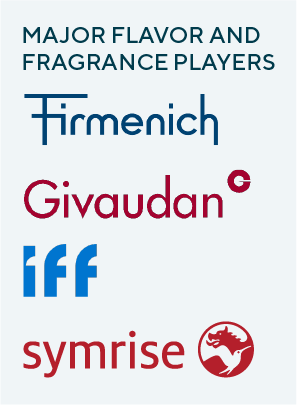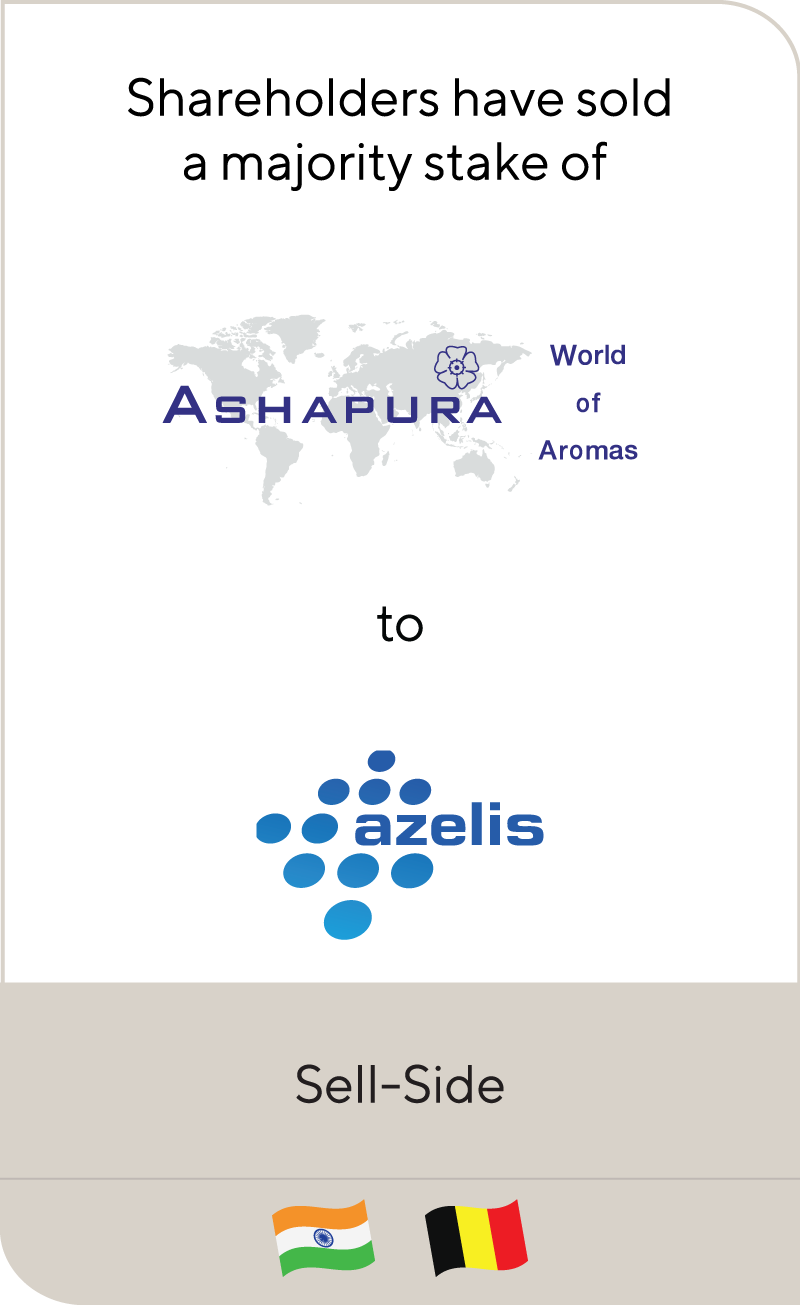Flavor and Fragrance Sector Continues to Blossom
Sep 2021
Flavors and fragrances (F&F) underpin a wide variety of consumer and industrial purchasing decisions , despite the fact they frequently only contribute a small percentage of the overall cost of the end product. In particular, scent is closely linked with a product’s efficacy, while flavors are the leading factor, influencing consumer preferences for food and beverage products. The global F&F sector continued to grow through the COVID-19 pandemic, while certain end markets were impacted negatively (e.g., industrial & institutional) others were more than offset (e.g., home care and cleaning products).
The current F&F market size is sizable with diverse applications. The global flavor market is estimated to be nearly $19 billion and includes the beverages, baker, savor and snacks, confectioneries and meats sectors. The global fragrances market is estimated to be more than $14 billion and includes the fine fragrances, personal care and cosmetics, household, industrial and institutional and air care sectors. Further, each sub-sector within the F&F sector has its own tailwinds. Therefore, diversification across categories can provide stability for investors in this high growth market.
The F&F sector is led by four major players: Firmenich, Givaudan, IFF and Symrise, who hold a majority of the global market. There is a vibrant second tier of global players, including ADM, Croda, Huabao, Mane, Robertet, S H Kelkar (Keva), Sensient, T. Hasegawa, Takasago and others. Outside the top four players there has been an ongoing trend of specializing within either fragrances or flavors. A recent example being Sensient’s divesting of its fragrance division to Symrise, in April 2021. Further, Nactarome’s focus on flavors and Agilex’s (Firmenich’s) focus on fragrances has proven this is an effective strategy for private equity backed companies as well.
As F&F is a truly global sector, consumer preferences and governmental regulations differ meaningfully from geography to geography, making mergers and acquisitions (M&A) an attractive option for deepening territorial expansion in addition to its classical role of supplementing growth. By acquiring an established player in the local market and providing additional corporate or institutional support there can frequently be highly achievable growth goals that can be measured in multiples of the initial size of the target. The global base of sizable F&F players with respective holes in their portfolio from either an application or geographical perspective will help to continue to drive competitive tensions in M&A processes.
Within the F&F value chain there are typically upstream producers and downstream formulators. The major providers will frequently cover both of these roles. However, there is opportunity for differentiation with the formulators who maintain direct connectivity with customers. High levels of customer service and formulation innovations can help a pure-play F&F formulator differentiate itself from the field, frequently with high margins. The fragrance sector is differentiated from the flavor sector in that a high proportion of fragrances still include a synthetic component to support the final scent. There are certain synthetic chemicals that are captive to different players within the big four, so that will always need to be a dynamic that a potential investor builds comfort around. Chemical distributors are not currently heavily involved in F&F formulation, but do further support formulators with their global networks and reach.
The barriers to entry in F&F are formidable and, along with the major growth drivers in this segment, are one of the primary reasons why F&F is consistently one of the highest trading EV / LTM EBITDA indices that we follow in the Lincoln International chemicals & materials sector tracking. Barriers to entry in the space include the proprietary formulations, the research and development (R&D) processes to fuel innovation, the in-house flavorists or perfumers and supporting technical staff and the tight regulatory environment. Switching costs are tremendous as consumers can detect even a slight change in the flavor or scent in a product. It is extremely difficult to unseat an existing flavor or fragrance without bringing a further efficacy, unique knowledge or differentiating characteristic to bear.
Summary
-
Lincoln International's chemicals sector experts explore trends that are heating up the flavor and fragrance sector.
- Click here to download a printable version of this perspective.
-

- Sign up to receive Lincoln's perspectives
When evaluating investments in the F&F space, it is important to consider several recent trends that continue to impact multiple end markets:
Increasing proliferation of consumer preferences and the rise of customization
The rise of social media and the increasingly global growth of the middle class is leading to ever heightening demands for micro-personalization. This frequently takes the shape of a unique flavor or scent that can be championed by a sub-group. Specific products, with custom flavors or fragrances, for different demographic groups and sub-groups is an angle that has shown deep resonance with consumers. Changing the flavor or fragrance while maintaining the same, or largely the same, underlying product is a highly cost effective way to bring an accessible level of personalization to the populace. As products shift towards or away from genderless scents there is a need for an update that signifies the uniqueness of the new product offering.
Growing focus on natural
Consumers are increasingly demanding “healthy / better for you products,” which are linked to the use of natural components. The increase in demand for clean label food products and clean fragrances is already driving this fast growing subset of the market, as natural flavors have more than doubled over the last decade, and will only continue to increase in importance moving forward. Consumer research groups have consistently shown a positive response to natural flavors and as more marketing campaigns highlight this, there is a growing willingness to pay for it. As more formulations are developed that incorporate natural bases in new ways, there will be opportunities for companies to further enhance margins. Of course, formulating using only natural ingredients can be a tremendous challenge for flavorists and perfumers when the target is maintaining the same flavor profile or product efficacy as before, though the successes in this space are well defensed from a barrier to entry perspective. This increasing consciousness of whether products are natural and what consumers are putting in or on their bodies will only continue to grow from here.
Use of odor neutralizers to mask malodors from chemical products
As scientists continue to develop either more effective solutions using new formulations or to re-engineer existing formulations utilizing biological-based ingredients, there is frequently a need to mask the base odor created. The trade off is that the increased efficacy of the solution or the “cleanliness” of the product results in a not altogether appealing scent. For example, if a laundry detergent manufacturer could reformulated its detergent solution to be 10x more effective with a similar cost profile, but in so doing created an unattractive scent, a fragrance formulator could provide a neutralizing agent to maintain efficacy while avoiding the malodor. There is also the preference from certain segments of the consumer population for more neutral scents for their everyday applications. These odor control additives can be included in existing formulations to help dampen unappealing scents, while allowing the ultimate desired scent, if there is one, to take center stage. As innovation in the chemicals world continues, it is expected that there will be an increasing need for a way to mask odors that are the result of an underlying highly effective application.
Contributor
Meet Professionals with Complementary Expertise in Chemicals

I am resolute in providing honest, insightful and pragmatic advice to clients.
Adam Hunia
Managing Director
ChicagoRelated Perspectives

Chemicals Quarterly Review Q4 2023
Expectations were low heading into the final three months of the year as stubbornly high interest rates caused a late summer downturn in the S&P 500. Despite a continued decline… Read More

Chemicals Quarterly Review Q3 2023
The economy exhibited modest growth over the summer, both fueling concerns about a potential recession and nurturing hopes that it might be averted. After two consecutive quarters of contraction, the… Read More

Chemicals Quarterly Review Q2 2023
Equities rallied in Q2 2023, with the S&P 500 gaining 16.9% year-to-date through June, driven primarily by artificial intelligence (AI)-fueled enthusiasm for large-cap technology stocks. The chemicals sector has been… Read More

Chemicals Quarterly Review Q1 2023
A growing push and pull demand for biobased chemical intermediate solutions will drive further mergers and acquisitions (M&A) activity. There is an ever increasing emphasis for more environmental, social and… Read More















